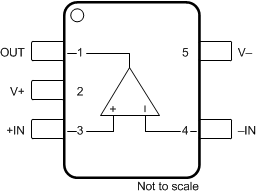-
TLV600x Low-Power, Rail-to-Rail In/Out, 1-MHz Operational Amplifier for Cost-Sensitive Systems
- 1 Features
- 2 Applications
- 3 Description
- 4 Revision History
- 5 Device Comparison Table
- 6 Pin Configuration and Functions
-
7 Specifications
- 7.1 Absolute Maximum Ratings
- 7.2 ESD Ratings
- 7.3 Recommended Operating Conditions
- 7.4 Thermal Information: TLV6001
- 7.5 Thermal Information: TLV6002
- 7.6 Thermal Information: TLV6004
- 7.7 Electrical Characteristics: VS= 1.8 V to 5 V (±0.9 V to ±2.75 V)
- 7.8 Typical Characteristics: Table of Graphs
- 7.9 Typical Characteristics
- 8 Detailed Description
- 9 Application and Implementation
- 10Power Supply Recommendations
- 11Layout
- 12Device and Documentation Support
- 13Mechanical, Packaging, and Orderable Information
- IMPORTANT NOTICE
Package Options
Mechanical Data (Package|Pins)
- PW|14
Thermal pad, mechanical data (Package|Pins)
Orderable Information
TLV600x Low-Power, Rail-to-Rail In/Out, 1-MHz Operational Amplifier for Cost-Sensitive Systems
1 Features
- Precision Amplifiers for Cost-Sensitive Systems
- Low Quiescent Current: 75 µA/ch
- Supply Range: 1.8 V to 5.5 V
- Input Voltage Noise Density: 28 nV/√Hz at 1 kHz
- Rail-to-Rail Input and Output
- Gain Bandwidth: 1 MHz
- Low Input Bias Current: 1 pA
- Low Offset Voltage: 0.75 mV
- Unity-Gain Stable
- Internal RF and EMI Filter
- Extended Temperature Range:
–40°C to +125°C
2 Applications
- Industrial and Consumer Electronics
- Portable Equipment
- Portable Blood Glucose Systems
- Smoke Detectors
- White Goods
- Power Banks
CMRR and PSRR vs Temperature

3 Description
The TLV600x family of single-, dual-, and quad-channel operational amplifiers is specifically designed for general-purpose applications. Featuring rail-to-rail input and output (RRIO) swings, low quiescent current (75 μA, typical), wide bandwidth (1 MHz) and low noise (28 nV/√Hz at 1 kHz), this family is attractive for a variety of applications that require a good balance between cost and performance, such as consumer electronics, smoke detectors, and white goods. The low-input-bias current (±1.0 pA, typical) enables the TLV600x to be used in applications with megaohm source impedances.
The robust design of the TLV600x provides ease-of-use to the circuit designer: unity-gain stability with capacitive loads of up to 150 pF, integrated RF/EMI rejection filter, no phase reversal in overdrive conditions, and high electrostatic discharge (ESD) protection (4-kV HBM).
The devices are optimized for operation at voltages as low as 1.8 V (±0.9 V) and up to 5.5 V (±2.75 V), and are specified over the extended temperature range of –40°C to +125°C.
The single-channel TLV6001 is available in SC70-5 and SOT23-5 packages. The dual-channel TLV6002 is offered in SOIC-8 and VSSOP-8 packages, and the quad-channel TLV6004 is offered in a TSSOP-14 package.
Device Information(1)
| PART NUMBER | PACKAGE | BODY SIZE (NOM) |
|---|---|---|
| TLV6001 | SC70 (5) | 2.00 mm × 1.25 mm |
| SOT-23 (5) | 2.90 mm × 1.60 mm | |
| TLV6002 | SOIC (8) | 4.90 mm × 3.91 mm |
| VSSOP (8) | 3.00 mm × 3.00 mm | |
| TLV6004 | TSSOP (14) | 5.00 mm × 4.40 mm |
- For all available packages, see the orderable addendum at the end of the data sheet.
4 Revision History
Changes from C Revision (December 2016) to D Revision
- Changed inverting input pin to noninverting input pin in Pin Functions: TLV6001 table Go
- Changed inverting input pin to noninverting input pin in Pin Functions: TLV6001R table Go
- Changed inverting input pin to noninverting input pin in Pin Functions: TLV6001U table Go
- Changed "Sample and Buy" to "Order Now" in Related Links table Go
Changes from B Revision (October 2016) to C Revision
- Changed all pin outs in Pin Configuration and Functions section to reflect correct pin names and orderGo
Changes from A Revision (July 2016) to B Revision
- Added TLV6001R pinout drawing to Pin Configurations and Functions section Go
- Added TLV6001U pinout drawing to Pin Configurations and Functions section Go
Changes from * Revision (June 2016) to A Revision
5 Device Comparison Table
| DEVICE | NO. OF CHANNELS |
PACKAGE-LEADS | ||||
|---|---|---|---|---|---|---|
| SC70 | SOT-23 | SOIC | VSSOP | TSSOP | ||
| TLV6001 | 1 | 5 | 5 | — | — | — |
| TLV6002 | 2 | — | — | 8 | 8 | — |
| TLV6004 | 4 | — | — | — | — | 14 |
6 Pin Configuration and Functions
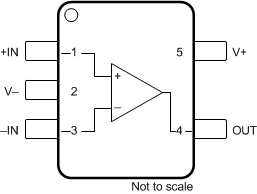
Pin Functions: TLV6001
Pin Functions: TLV6001R
| PIN | I/O | DESCRIPTION | |
|---|---|---|---|
| NAME | NO. | ||
| –IN | 4 | I | Inverting input |
| +IN | 3 | I | Noninverting input |
| OUT | 1 | O | Output |
| V– | 5 | — | Negative (lowest) power supply |
| V+ | 2 | — | Positive (highest) power supply |
Pin Functions: TLV6001U
| PIN | I/O | DESCRIPTION | |
|---|---|---|---|
| NAME | NO. | ||
| –IN | 3 | I | Inverting input |
| +IN | 1 | I | Noninverting input |
| OUT | 4 | O | Output |
| V– | 2 | — | Negative (lowest) power supply |
| V+ | 5 | — | Positive (highest) power supply |
Pin Functions: TLV6002
| PIN | I/O | DESCRIPTION | ||
|---|---|---|---|---|
| NAME | D (SOIC) | DGK (VSSOP) | ||
| –IN A | 2 | 2 | I | Inverting input, channel A |
| –IN B | 6 | 6 | I | Inverting input, channel B |
| +IN A | 3 | 3 | I | Noninverting input, channel A |
| +IN B | 5 | 5 | I | Noninverting input, channel B |
| OUT A | 1 | 1 | O | Output, channel A |
| OUT B | 7 | 7 | O | Output, channel B |
| V– | 4 | 4 | — | Negative (lowest) power supply |
| V+ | 8 | 8 | — | Positive (highest) power supply |
Pin Functions: TLV6004
| PIN | I/O | DESCRIPTION | |
|---|---|---|---|
| NAME | NO. | ||
| –IN A | 2 | I | Inverting input, channel A |
| –IN B | 6 | I | Inverting input, channel B |
| –IN C | 9 | I | Inverting input, channel C |
| –IN D | 13 | I | Inverting input, channel D |
| +IN A | 3 | I | Noninverting input, channel A |
| +IN B | 5 | I | Noninverting input, channel B |
| +IN C | 10 | I | Noninverting input, channel C |
| +IN D | 12 | I | Noninverting input, channel D |
| OUT A | 1 | O | Output, channel A |
| OUT B | 7 | O | Output, channel B |
| OUT C | 8 | O | Output, channel C |
| OUT D | 14 | O | Output, channel D |
| V– | 11 | — | Negative (lowest) power supply |
| V+ | 4 | — | Positive (highest) power supply |
7 Specifications
7.1 Absolute Maximum Ratings
over operating free-air temperature range (unless otherwise noted)(1)| MIN | MAX | UNIT | ||
|---|---|---|---|---|
| Voltage | Supply voltage | 7 | V | |
| Signal input pins, voltage(2) | (V–) – 0.5 | (V+) + 0.5 | V | |
| Current | Signal input pins, current(2) | –10 | 10 | mA |
| Output short-circuit(3) | Continuous | mA | ||
| Temperature | Operating, TA | –40 | 150 | °C |
| Junction, TJ | 150 | °C | ||
| Storage, Tstg | –65 | 150 | °C | |
7.2 ESD Ratings
| VALUE | UNIT | |||
|---|---|---|---|---|
| V(ESD) | Electrostatic discharge | Human-body model (HBM), per ANSI/ESDA/JEDEC JS-001(1) | ±4000 | V |
| Charged-device model (CDM), per JEDEC specification JESD22-C101(2) | ±1000 | |||
7.3 Recommended Operating Conditions
over operating free-air temperature range (unless otherwise noted)| MIN | MAX | UNIT | ||
|---|---|---|---|---|
| VS | Supply voltage | 1.8 | 5.5 | V |
| TA | Specified temperature range | –40 | 125 | °C |
7.4 Thermal Information: TLV6001
| THERMAL METRIC(1) | TLV6001 | UNIT | ||
|---|---|---|---|---|
| DBV (SOT-23) | DCK (SC70) | |||
| 5 PINS | 5 PINS | |||
| RθJA | Junction-to-ambient thermal resistance | 228.5 | 281.4 | °C/W |
| RθJC(top) | Junction-to-case (top) thermal resistance | 99.1 | 91.6 | °C/W |
| RθJB | Junction-to-board thermal resistance | 54.6 | 59.6 | °C/W |
| ψJT | Junction-to-top characterization parameter | 7.7 | 1.5 | °C/W |
| ψJB | Junction-to-board characterization parameter | 53.8 | 58.8 | °C/W |
| RθJC(bot) | Junction-to-case (bottom) thermal resistance | N/A | N/A | °C/W |
7.5 Thermal Information: TLV6002
| THERMAL METRIC(1) | TLV6002 | UNIT | ||
|---|---|---|---|---|
| D (SOIC) | DGK (VSSOP) | |||
| 8 PINS | 8 PINS | |||
| RθJA | Junction-to-ambient thermal resistance | 138.4 | 191.2 | °C/W |
| RθJC(top) | Junction-to-case (top) thermal resistance | 89.5 | 61.9 | °C/W |
| RθJB | Junction-to-board thermal resistance | 78.6 | 111.9 | °C/W |
| ψJT | Junction-to-top characterization parameter | 29.9 | 5.1 | °C/W |
| ψJB | Junction-to-board characterization parameter | 78.1 | 110.2 | °C/W |
| RθJC(bot) | Junction-to-case (bottom) thermal resistance | N/A | N/A | °C/W |
7.6 Thermal Information: TLV6004
| THERMAL METRIC(1) | TLV6004 | UNIT | |
|---|---|---|---|
| PW (TSSOP) | |||
| 14 PINS | |||
| RθJA | Junction-to-ambient thermal resistance | 121.0 | °C/W |
| RθJC(top) | Junction-to-case (top) thermal resistance | 49.4 | °C/W |
| RθJB | Junction-to-board thermal resistance | 62.8 | °C/W |
| ψJT | Junction-to-top characterization parameter | 5.9 | °C/W |
| ψJB | Junction-to-board characterization parameter | 62.2 | °C/W |
| RθJC(bot) | Junction-to-case (bottom) thermal resistance | N/A | °C/W |
7.7 Electrical Characteristics: VS= 1.8 V to 5 V (±0.9 V to ±2.75 V)(1)
at TA = 25°C, RL = 10 kΩ connected to VS / 2, and VCM = VOUT = VS / 2, unless otherwise noted.
| PARAMETER | TEST CONDITIONS | MIN | TYP | MAX | UNIT | ||
|---|---|---|---|---|---|---|---|
| OFFSET VOLTAGE | |||||||
| VOS | Input offset voltage | 0.75 | 4.5 | mV | |||
| dVOS/dT | VOS vs temperature | TA = –40°C to 125°C | 2 | μV/°C | |||
| PSRR | Power-supply rejection ratio | 86 | dB | ||||
| INPUT BIAS CURRENT | |||||||
| IB | Input bias current | TA = 25°C | ±1.0 | pA | |||
| IOS | Input offset current | ±1.0 | pA | ||||
| INPUT IMPEDANCE | |||||||
| ZID | Differential | 100 || 1 | MΩ || pF | ||||
| ZIC | Common-mode | 1 || 5 | 1013Ω || pF | ||||
| INPUT VOLTAGE RANGE | |||||||
| VCM | Common-mode voltage range | No phase reversal, rail-to-rail input | (V–) – 0.2 | (V+) + 0.2 | V | ||
| CMRR | Common-mode rejection ratio | VCM = –0.2 V to 5.7 V | 60 | 76 | dB | ||
| OPEN-LOOP GAIN | |||||||
| AOL | Open-loop voltage gain | 0.3 V < VO < (V+) – 0.3 V, RL = 2 kΩ | 90 | 110 | |||
| Phase margin | VS = 5.0 V, G = +1 | 65 | degrees | ||||
| OUTPUT | |||||||
| VO | Voltage output swing from supply rails | RL = 100 kΩ | 5 | mV | |||
| RL = 2 kΩ | 75 | 100 | mV | ||||
| ISC | Short-circuit current | ±15 | mA | ||||
| RO | Open-loop output impedance | 2300 | Ω | ||||
| FREQUENCY RESPONSE | |||||||
| GBW | Gain-bandwidth product | 1 | MHz | ||||
| SR | Slew rate | 0.5 | V/µs | ||||
| tS | Settling time | To 0.1%, VS = 5.0 V, 2-V step , G = +1 | 5 | μs | |||
| NOISE | |||||||
| Input voltage noise (peak-to-peak) | f = 0.1 Hz to 10 Hz | 6 | μVPP | ||||
| en | Input voltage noise density | f = 1 kHz | 28 | nV/√Hz | |||
| in | Input current noise density | f = 1 kHz | 5 | fA/√Hz | |||
| POWER SUPPLY | |||||||
| VS | Specified voltage range | 1.8 (±0.9) | 5.5 (±2.75) | V | |||
| IQ | Quiescent current per amplifier | IO = 0 mA, VS = 5.0 V | 75 | 100 | µA | ||
| Power-on time | VS = 0 V to 5 V, to 90% IQ level | 10 | µs | ||||
7.8 Typical Characteristics: Table of Graphs
Table 1. Table of Graphs
| TITLE | FIGURE |
|---|---|
| Open-Loop Gain and Phase vs Frequency | Figure 1 |
| Quiescent Current vs Supply Voltage | Figure 2 |
| Offset Voltage Production Distribution | Figure 3 |
| Offset Voltage vs Common-Mode Voltage (Maximum Supply) | Figure 4 |
| CMRR and PSRR vs Frequency (RTI) | Figure 5 |
| 0.1-Hz to 10-Hz Input Voltage Noise (5.5 V) | Figure 6 |
| Input Voltage Noise Spectral Density vs Frequency (1.8 V, 5.5 V) | Figure 7 |
| Input Bias and Offset Current vs Temperature | Figure 8 |
| Open-Loop Output Impedance vs Frequency | Figure 9 |
| Maximum Output Voltage vs Frequency and Supply Voltage | Figure 10 |
| Output Voltage Swing vs Output Current (over Temperature) | Figure 11 |
| Closed-Loop Gain vs Frequency, G = 1, –1, 10 (1.8 V) | Figure 12 |
| Small-Signal Step Response, Noninverting (1.8 V) | Figure 13 |
| Small-Signal Step Response, Noninverting ( 5.5 V) | Figure 14 |
| Large-Signal Step Response, Noninverting (1.8 V) | Figure 15 |
| Large-Signal Step Response, Noninverting ( 5.5 V) | Figure 16 |
| No Phase Reversal | Figure 17 |
| EMIRR IN+ vs Frequency | Figure 18 |
7.9 Typical Characteristics
at TA = 25°C, VS = 5 V, RL = 10 kΩ connected to VS / 2, and VCM = VOUT = VS / 2, unless otherwise noted.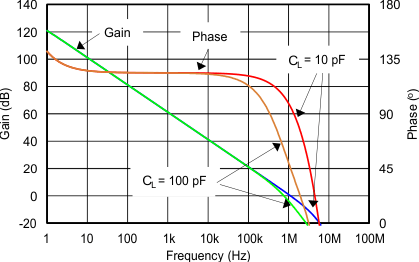
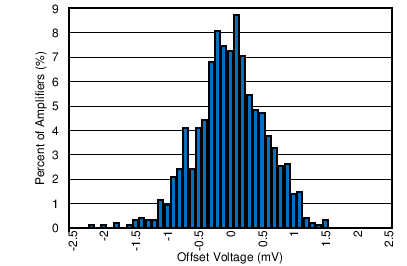
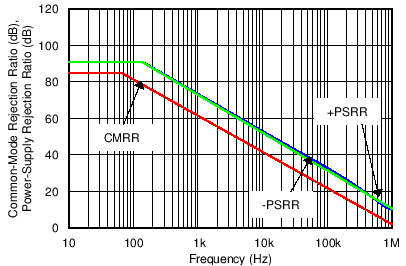
(Referred-to-Input)
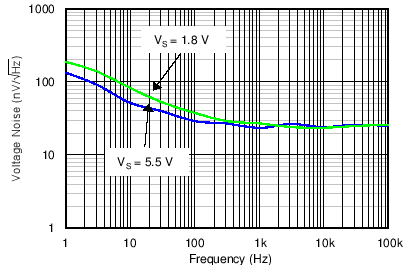
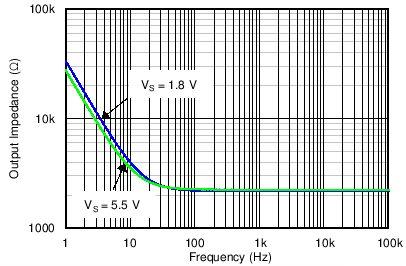
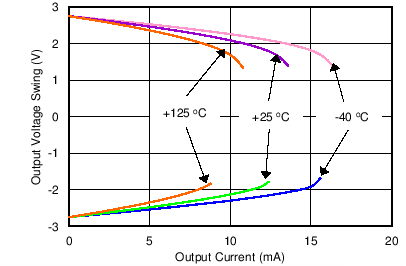
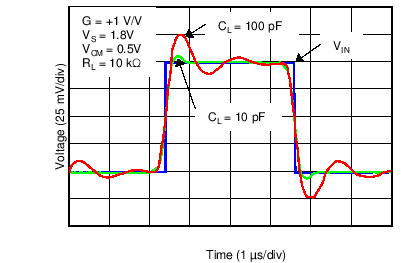
(Minimum Supply)
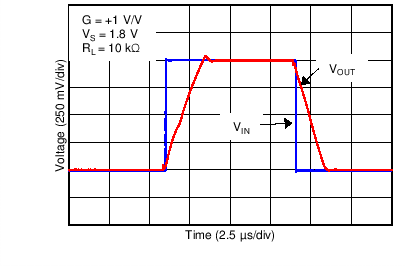
(Minimum Supply)
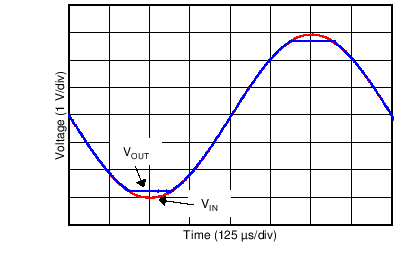
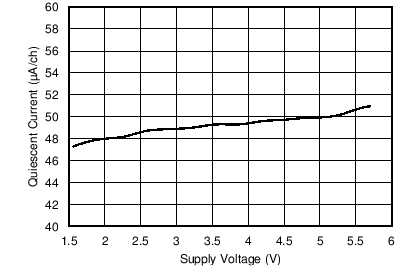
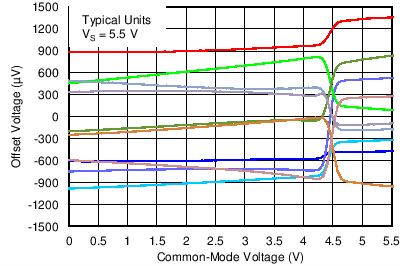
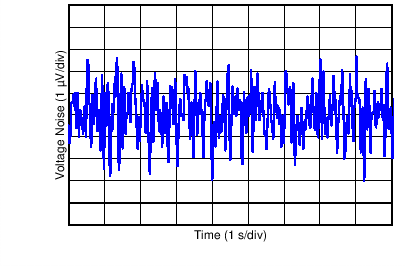
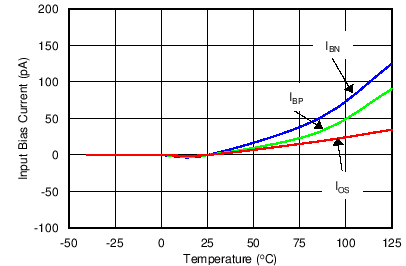
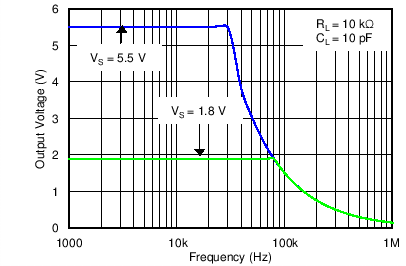
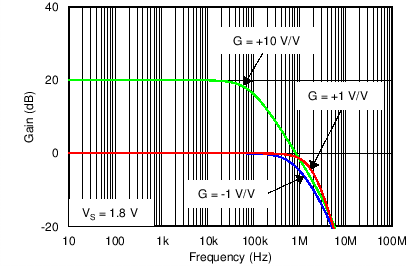
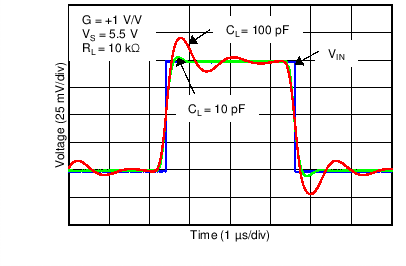
(Maximum Supply)
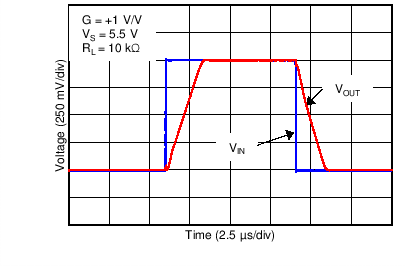
(Maximum Supply)
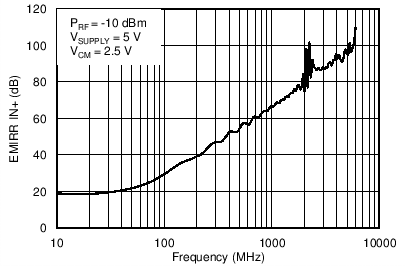
8 Detailed Description
8.1 Overview
The TLV600x family of operational amplifiers are general-purpose, low-cost devices that are suitable for a wide range of portable applications. Rail-to-rail input and output swings, low quiescent current, and wide dynamic range make the op amps well-suited for driving sampling analog-to-digital converters (ADCs) and other single-supply applications.
8.2 Functional Block Diagram
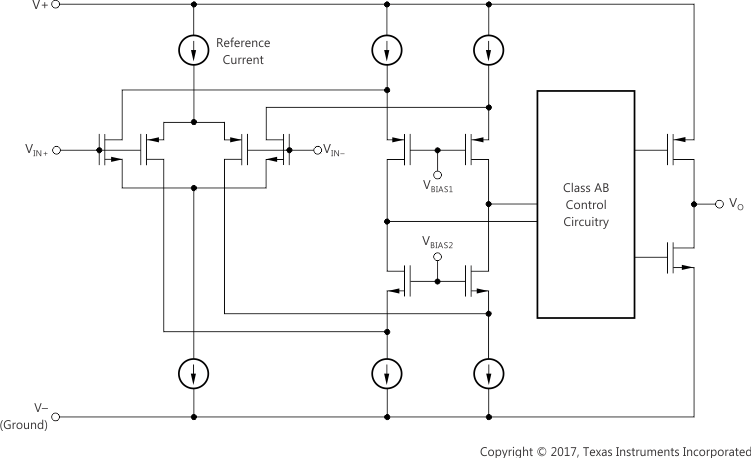
8.3 Feature Description
8.3.1 Operating Voltage
The TLV600x series is fully specified and tested from 1.8 V to 5.5 V (±0.9 V to ±2.75 V). Parameters that vary with supply voltage are illustrated in the Typical Characteristics section.
8.3.2 Rail-to-Rail Input
The input common-mode voltage range of the TLV600x series extends 200 mV beyond the supply rails. This performance is achieved with a complementary input stage: an N-channel input differential pair in parallel with a P-channel differential pair, as shown in the Functional Block Diagram. The N-channel pair is active for input voltages close to the positive rail, typically (V+) – 1.3 V to 200 mV above the positive supply, while the P-channel pair is on for inputs from 200 mV below the negative supply to approximately (V+) – 1.3 V. There is a small transition region, typically (V+) – 1.4 V to (V+) – 1.2 V, in which both pairs are on. This 200-mV transition region may vary up to 300 mV with process variation. Thus, the transition region (both stages on) may range from (V+) – 1.7 V to (V+) – 1.5 V on the low end, up to (V+) – 1.1 V to (V+) – 0.9 V on the high end. Within this transition region, PSRR, CMRR, offset voltage, offset drift, and THD may be degraded compared to device operation outside this region.
8.3.3 Rail-to-Rail Output
Designed as a micro-power, low-noise operational amplifier, the TLV600x delivers a robust output drive capability. A class AB output stage with common-source transistors is used to achieve full rail-to-rail output swing capability. For resistive loads up to 100 kΩ, the output swings typically to within 5 mV of either supply rail regardless of the power-supply voltage applied. Different load conditions change the ability of the amplifier to swing close to the rails, as shown in Figure 11.
8.3.4 Common-Mode Rejection Ratio (CMRR)
CMRR for the TLV600x is specified in several ways so the best match for a given application may be used; see Electrical Characteristics. First, the CMRR of the device in the common-mode range below the transition region [VCM < (V+) – 1.3 V] is given. This specification is the best indicator of the capability of the device when the application requires the use of one of the differential input pairs. Second, the CMRR over the entire common-mode range is specified at (VCM = –0.2 V to 5.7 V). This last value includes the variations seen through the transition region, as shown in Figure 4.
8.3.5 Capacitive Load and Stability
The TLV600x is designed to be used in applications where driving a capacitive load is required. As with all op amps, there may be specific instances where the TLV600x may become unstable. The particular op amp circuit configuration, layout, gain, and output loading are some of the factors to consider when establishing whether or not an amplifier is stable in operation. An op amp in the unity-gain (1-V/V) buffer configuration that drives a capacitive load exhibits a greater tendency to be unstable than an amplifier operated at a higher noise gain. The capacitive load, in conjunction with the op amp output resistance, creates a pole within the feedback loop that degrades the phase margin. The degradation of the phase margin increases as the capacitive loading increases. When operating in the unity-gain configuration, the TLV600x remains stable with a pure capacitive load up to approximately 1 nF. The equivalent series resistance (ESR) of some capacitors (CL greater than 1 μF) is sufficient to alter the phase characteristics in the feedback loop such that the amplifier remains stable. Increasing the amplifier closed-loop gain allows the amplifier to drive increasingly larger capacitance. This increased capability is evident when observing the overshoot response of the amplifier at higher voltage gains.
One technique for increasing the capacitive load drive capability of the amplifier when it operates in a unity-gain configuration is to insert a small resistor, typically 10 Ω to 20 Ω, in series with the output, as shown in Figure 19. This resistor significantly reduces the overshoot and ringing associated with large capacitive loads. One possible problem with this technique is that a voltage divider is created with the added series resistor and any resistor connected in parallel with the capacitive load. The voltage divider introduces a gain error at the output that reduces the output swing.
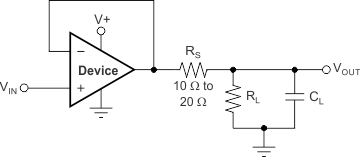 Figure 19. Improving Capacitive Load Drive
Figure 19. Improving Capacitive Load Drive
8.3.6 EMI Susceptibility and Input Filtering
Operational amplifiers vary with regard to the susceptibility of the device to electromagnetic interference (EMI). If conducted EMI enters the op amp, the dc offset observed at the amplifier output may shift from the nominal value while EMI is present. This shift is a result of signal rectification associated with the internal semiconductor junctions. While all op amp pin functions may be affected by EMI, the signal input pins are likely to be the most susceptible. The TLV600x family incorporates an internal input low-pass filter that reduces the amplifiers response to EMI. Common-mode and differential mode filtering are provided by this filter. The filter is designed for a cutoff frequency of approximately 35 MHz (–3 dB), with a rolloff of 20 dB per decade.
Texas Instruments has developed the ability to accurately measure and quantify the immunity of an operational amplifier over a broad frequency spectrum extending from 10 MHz to 6 GHz. The EMI rejection ratio (EMIRR) metric allows op amps to be directly compared by the EMI immunity. Figure 18 illustrates the results of this testing on the TLV600x family. Detailed information may be found in EMI Rejection Ratio of Operational Amplifiers (SBOA128), available for download from www.ti.com.
8.4 Device Functional Modes
The TLV600x have a single functional mode. The devices are powered on as long as the power-supply voltage is between 1.8 V (±0.9 V) and 5.5 V (±2.75 V).
8.5 Input and ESD Protection
The TLV600x incorporates internal electrostatic discharge (ESD) protection circuits on all pins. In the case of input and output pins, this protection primarily consists of current-steering diodes connected between the input and power-supply pins. The ESD protection diodes provide in-circuit, input overdrive protection, as long as the current is limited to 10 mA, as stated in the Absolute Maximum Ratings table. Figure 20 shows how a series input resistor may be added to the driven input to limit the input current. The added resistor contributes thermal noise at the amplifier input and the value must be kept to a minimum in noise-sensitive applications.
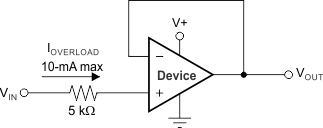 Figure 20. Input Current Protection
Figure 20. Input Current Protection
9 Application and Implementation
NOTE
Information in the following applications sections is not part of the TI component specification, and TI does not warrant its accuracy or completeness. TI’s customers are responsible for determining suitability of components for their purposes. Customers should validate and test their design implementation to confirm system functionality.
9.1 Application Information
The TLV600x is a family of low-power, rail-to-rail input and output operational amplifiers specifically designed for portable applications. The devices operate from 1.8 V to 5.5 V, are unity-gain stable, and are suitable for a wide range of general-purpose applications. The class AB output stage is capable of driving ≤ 10-kΩ loads connected to any point between V+ and ground. The input common-mode voltage range includes both rails, and allows the TLV600x to be used in any single-supply application.
9.2 Typical Application
A typical application for an operational amplifier is an inverting amplifier, as shown in Figure 21. An inverting amplifier takes a positive voltage on the input and outputs a signal inverted to the input, making a negative voltage of the same magnitude. In the same manner, the amplifier makes negative input voltages positive on the output. In addition, amplification may be added by selecting the input resistor RI and the feedback resistor RF.
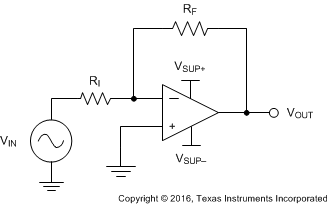 Figure 21. Application Schematic
Figure 21. Application Schematic
9.2.1 Design Requirements
The supply voltage must be chosen to be larger than the input voltage range and the desired output range. The limits of the input common-mode range (VCM) and the output voltage swing to the rails (VO) must be considered. For instance, this application scales a signal of ±0.5 V (1 V) to ±1.8 V (3.6 V). Setting the supply at ±2.5 V is sufficient to accommodate this application.
9.2.2 Detailed Design Procedure
Determine the gain required by the inverting amplifier using Equation 1 and Equation 2:


When the desired gain is determined, choose a value for RI or RF. Choosing a value in the kilohm range is desirable for general-purpose applications because the amplifier circuit uses currents in the milliamp range. This milliamp current range ensures the device does not draw too much current. The trade-off is that large resistors (hundreds of kilohms) draw the smallest current but generate the highest noise. Small resistors (100s of ohms) generate low noise but draw high current. This example uses 10 kΩ for RI, meaning 36 kΩ is used for RF. The values are determined by Equation 3:

9.2.3 Application Curve
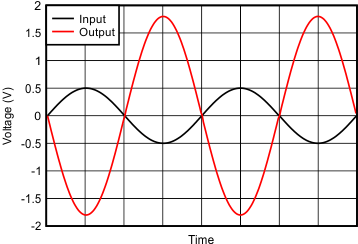 Figure 22. Inverting Amplifier Input and Output
Figure 22. Inverting Amplifier Input and Output
9.3 System Examples
When receiving low-level signals, limiting the bandwidth of the incoming signals into the system is often required. The simplest way to establish this limited bandwidth is to place an RC filter at the noninverting terminal of the amplifier, as shown in Figure 23.
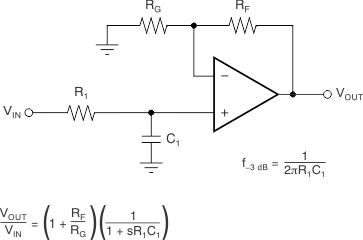 Figure 23. Single-Pole Low-Pass Filter
Figure 23. Single-Pole Low-Pass Filter
If even more attenuation is needed, a multiple pole filter is required. The Sallen-Key filter may be used for this task, as shown in Figure 24. For best results, the amplifier must have a bandwidth that is eight to 10 times the filter frequency bandwidth. Failure to follow this guideline may result in phase shift of the amplifier.
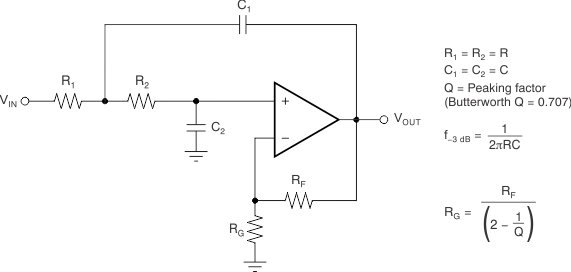 Figure 24. Two-Pole, Low-Pass, Sallen-Key Filter
Figure 24. Two-Pole, Low-Pass, Sallen-Key Filter
10 Power Supply Recommendations
The TLV600x is specified for operation from 1.8 V to 5.5 V (±0.9 V to ±2.75 V); many specifications apply from –40°C to +125°C. The Typical Characteristics presents parameters that may exhibit significant variance with regard to operating voltage or temperature.
CAUTION
Supply voltages larger than 7 V may permanently damage the device. (See the Absolute Maximum Ratings table).
Place 0.1-μF bypass capacitors close to the power-supply pins to reduce errors coupling in from noisy or high-impedance power supplies. For more detailed information on bypass capacitor placement, see Layout Guidelines.
11 Layout
11.1 Layout Guidelines
For best operational performance of the device, use good printed circuit board (PCB) layout practices, including:
- Noise may propagate into analog circuitry through the power pins of the circuit and the operational amplifier. Use bypass capacitors to reduce the coupled noise by providing low-impedance power sources local to the analog circuitry.
- Connect low-ESR, 0.1-µF ceramic bypass capacitors between each supply pin and ground, placed as close to the device as possible. A single bypass capacitor from V+ to ground is applicable for single-supply applications.
- Separate grounding for analog and digital portions of the circuitry is one of the simplest and most effective methods of noise suppression. One or more layers on multilayer PCBs are typically devoted to ground planes. A ground plane helps distribute heat and reduces EMI noise pickup. Take care to physically separate digital and analog grounds, paying attention to the flow of the ground current. For more detailed information, refer to Circuit Board Layout Techniques (SLOA089).
- To reduce parasitic coupling, run the input traces as far away from the supply or output traces as possible. If the traces cannot be kept separate, crossing the sensitive trace perpendicularly is much better than crossing in parallel with the noisy trace.
- Place the external components as close to the device as possible. Keep RF and RG close to the inverting input in order to minimize parasitic capacitance, as shown in Figure 25.
- Keep the length of input traces as short as possible. Remember that the input traces are the most sensitive part of the circuit.
- Consider a driven, low-impedance guard ring around the critical traces. A guard ring may significantly reduce leakage currents from nearby traces that are at different potentials.
11.2 Layout Example
 Figure 25. Operational Amplifier Board Layout for Noninverting Configuration
Figure 25. Operational Amplifier Board Layout for Noninverting Configuration
 Figure 26. Schematic Representation of Figure 25
Figure 26. Schematic Representation of Figure 25
12 Device and Documentation Support
12.1 Documentation Support
12.1.1 Related Documentation
For related documentation, see the following:
- EMI Rejection Ratio of Operational Amplifiers (SBOA128)
- Circuit Board Layout Techniques (SLOA089)
12.2 Related Links
Table 2 lists quick access links. Categories include technical documents, support and community resources, tools and software, and quick access to sample or buy.
Table 2. Related Links
| PARTS | PRODUCT FOLDER | ORDER NOW | TECHNICAL DOCUMENTS | TOOLS & SOFTWARE | SUPPORT & COMMUNITY |
|---|---|---|---|---|---|
| TLV6001 | Click here | Click here | Click here | Click here | Click here |
| TLV6002 | Click here | Click here | Click here | Click here | Click here |
| TLV6004 | Click here | Click here | Click here | Click here | Click here |
12.3 Receiving Notification of Documentation Updates
To receive notification of documentation updates, navigate to the device product folder on ti.com. In the upper right corner, click on Alert me to register and receive a weekly digest of any product information that has changed. For change details, review the revision history included in any revised document.
12.4 Community Resources
The following links connect to TI community resources. Linked contents are provided "AS IS" by the respective contributors. They do not constitute TI specifications and do not necessarily reflect TI's views; see TI's Terms of Use.
-
TI E2E™ Online Community TI's Engineer-to-Engineer (E2E) Community. Created to foster collaboration among engineers. At e2e.ti.com, you can ask questions, share knowledge, explore ideas and help solve problems with fellow engineers.
-
Design Support TI's Design Support Quickly find helpful E2E forums along with design support tools and contact information for technical support.
12.5 Trademarks
E2E is a trademark of Texas Instruments.
All other trademarks are the property of their respective owners.
12.6 Electrostatic Discharge Caution

This integrated circuit can be damaged by ESD. Texas Instruments recommends that all integrated circuits be handled with appropriate precautions. Failure to observe proper handling and installation procedures can cause damage.
ESD damage can range from subtle performance degradation to complete device failure. Precision integrated circuits may be more susceptible to damage because very small parametric changes could cause the device not to meet its published specifications.
12.7 Glossary
SLYZ022 — TI Glossary.
This glossary lists and explains terms, acronyms, and definitions.
13 Mechanical, Packaging, and Orderable Information
The following pages include mechanical, packaging, and orderable information. This information is the most current data available for the designated devices. This data is subject to change without notice and revision of this document. For browser-based versions of this data sheet, refer to the left-hand navigation.
IMPORTANT NOTICE
Texas Instruments Incorporated (TI) reserves the right to make corrections, enhancements, improvements and other changes to its semiconductor products and services per JESD46, latest issue, and to discontinue any product or service per JESD48, latest issue. Buyers should obtain the latest relevant information before placing orders and should verify that such information is current and complete.
TI’s published terms of sale for semiconductor products (http://www.ti.com/sc/docs/stdterms.htm) apply to the sale of packaged integrated circuit products that TI has qualified and released to market. Additional terms may apply to the use or sale of other types of TI products and services.
Reproduction of significant portions of TI information in TI data sheets is permissible only if reproduction is without alteration and is accompanied by all associated warranties, conditions, limitations, and notices. TI is not responsible or liable for such reproduced documentation. Information of third parties may be subject to additional restrictions. Resale of TI products or services with statements different from or beyond the parameters stated by TI for that product or service voids all express and any implied warranties for the associated TI product or service and is an unfair and deceptive business practice. TI is not responsible or liable for any such statements.
Buyers and others who are developing systems that incorporate TI products (collectively, “Designers”) understand and agrees that Designers remain responsible for using their independent analysis, evaluation and judgment in designing their systems and products, and have full and exclusive responsibility to assure the safety of their products and compliance of their products (and of all TI products used in or for such Designers’ products) with all applicable regulations, laws and other applicable requirements. Designers represent that, with respect to their applications, they have all the necessary expertise to create and implement safeguards that (1) anticipate dangerous consequences of failures, (2) monitor failures and their consequences, and (3) lessen the likelihood of failures that might cause harm and take appropriate actions. Designers agree that prior to using or distributing any systems that include TI products, they will thoroughly test such systems and the functionality of such TI products as used in such systems.
TI’s provision of reference designs and any other technical, applications or design advice, quality characterization, reliability data or other information or services does not expand or otherwise alter TI’s applicable published warranties or warranty disclaimers for TI products, and no additional obligations or liabilities arise from TI providing such reference designs or other items.
Designers are authorized to use, copy and modify any individual TI reference design only in connection with the development of end products that include the TI product(s) identified in that reference design. HOWEVER, NO OTHER LICENSE, EXPRESS OR IMPLIED, BY ESTOPPEL OR OTHERWISE TO ANY OTHER TI INTELLECTUAL PROPERTY RIGHT, AND NO LICENSE TO ANY TECHNOLOGY OR INTELLECTUAL PROPERTY RIGHT OF TI OR ANY THIRD PARTY IS GRANTED HEREIN, including but not limited to any patent right, copyright, mask work right, or other intellectual property right relating to any combination, machine, or process in which TI products or services are used. Information published by TI regarding third-party products or services does not constitute a license to use such products or services, or a warranty or endorsement thereof. Use of the reference design or other items described above may require a license from a third party under the patents or other intellectual property of the third party, or a license from TI under the patents or other intellectual property of TI.
TI REFERENCE DESIGNS AND OTHER ITEMS DESCRIBED ABOVE ARE PROVIDED “AS IS” AND WITH ALL FAULTS. TI DISCLAIMS ALL OTHER WARRANTIES OR REPRESENTATIONS, EXPRESS OR IMPLIED, REGARDING THE REFERENCE DESIGNS OR USE OF THE REFERENCE DESIGNS, INCLUDING BUT NOT LIMITED TO ACCURACY OR COMPLETENESS, TITLE, ANY EPIDEMIC FAILURE WARRANTY AND ANY IMPLIED WARRANTIES OF MERCHANTABILITY, FITNESS FOR A PARTICULAR PURPOSE, AND NON-INFRINGEMENT OF ANY THIRD PARTY INTELLECTUAL PROPERTY RIGHTS.
TI SHALL NOT BE LIABLE FOR AND SHALL NOT DEFEND OR INDEMNIFY DESIGNERS AGAINST ANY CLAIM, INCLUDING BUT NOT LIMITED TO ANY INFRINGEMENT CLAIM THAT RELATES TO OR IS BASED ON ANY COMBINATION OF PRODUCTS AS DESCRIBED IN A TI REFERENCE DESIGN OR OTHERWISE. IN NO EVENT SHALL TI BE LIABLE FOR ANY ACTUAL, DIRECT, SPECIAL, COLLATERAL, INDIRECT, PUNITIVE, INCIDENTAL, CONSEQUENTIAL OR EXEMPLARY DAMAGES IN CONNECTION WITH OR ARISING OUT OF THE REFERENCE DESIGNS OR USE OF THE REFERENCE DESIGNS, AND REGARDLESS OF WHETHER TI HAS BEEN ADVISED OF THE POSSIBILITY OF SUCH DAMAGES.
Unless TI has explicitly designated an individual product as meeting the requirements of a particular industry standard (e.g., ISO/TS 16949 and ISO 26262), TI is not responsible for any failure to meet such industry standard requirements.
Where TI specifically promotes products as facilitating functional safety or as compliant with industry functional safety standards, such products are intended to help enable customers to design and create their own applications that meet applicable functional safety standards and requirements. Using products in an application does not by itself establish any safety features in the application. Designers must ensure compliance with safety-related requirements and standards applicable to their applications. Designer may not use any TI products in life-critical medical equipment unless authorized officers of the parties have executed a special contract specifically governing such use. Life-critical medical equipment is medical equipment where failure of such equipment would cause serious bodily injury or death (e.g., life support, pacemakers, defibrillators, heart pumps, neurostimulators, and implantables). Such equipment includes, without limitation, all medical devices identified by the U.S. Food and Drug Administration as Class III devices and equivalent classifications outside the U.S.
TI may expressly designate certain products as completing a particular qualification (e.g., Q100, Military Grade, or Enhanced Product). Designers agree that it has the necessary expertise to select the product with the appropriate qualification designation for their applications and that proper product selection is at Designers’ own risk. Designers are solely responsible for compliance with all legal and regulatory requirements in connection with such selection.
Designer will fully indemnify TI and its representatives against any damages, costs, losses, and/or liabilities arising out of Designer’s non-compliance with the terms and provisions of this Notice.
IMPORTANT NOTICE
| Mailing Address: Texas Instruments, Post Office Box 655303, Dallas, Texas 75265 Copyright © 2017, Texas Instruments Incorporated |
